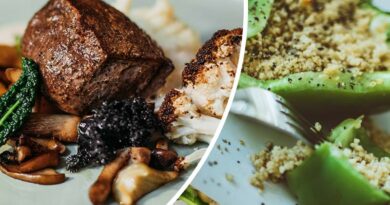National Food Strategy – call for evidence

Summary
* In August 2019, plans were announced to devise a National Food Strategy for England. The strategy aims to establish a food system that meets a number of goals – from human health to sustainable agriculture.
* Submissions were invited to be received by 25th October 2019. Responses were required to be 1,000 words or fewer – excluding references and supporting material. This week’s note contains my (verbatim) submission.
* There were many approaches that could have been taken. I decided to focus on the nutritional aspect of food, with just a brief mention of conflicts of interest and the need to protect topsoil.
* I took the same approach that I took at the College of Medicine conference in London last week when I gave a presentation with the title: What should we eat? Essential nutrients are things that we must consume in our diet. Given this fact, it seems obvious to ask – where do we find those essential nutrients? From essential fats, to complete protein, to vitamins, and to minerals – there is a consistent answer to the question: what should we eat? Unfortunately, the answer doesn’t match current dietary advice.
Introduction
On 16th August 2019, plans were announced to devise a National Food Strategy for England. (This is just one of the four parts of the UK, but invariably Wales, Scotland and Northern Ireland adopt English government initiatives). A video was launched to announce the aims (Ref 1). I watched the video at the time, and I was surprised to see, when I went back to view it yesterday, that it had been viewed just 253 times – a few of those having been me!
The important aspects of the terms of reference are purpose – what does the strategy hope to achieve? Scope – how broad a remit does it have? And timing – when will it deliver? The answers from the literature accompanying the initiative are (Ref 2):
Purpose: It is intended to be an overarching strategy for government, designed to ensure that our food system:
– delivers safe, healthy, affordable food; regardless of where people live or how much they earn;
– is robust in the face of future shocks;
– restores and enhances the natural environment for the next generation in this country;
– is built upon a resilient, sustainable and humane agriculture sector;
– is a thriving contributor to our urban and rural economies, delivering well paid jobs and supporting innovative producers and manufacturers across the country;
– delivers all this in an efficient and cost effective way.
Scope: The strategy will cover the entire food chain, from field to fork: the production, marketing, processing, sale and purchase of food (for consumption in the home and out of it), and the consumer practices, resources and institutions involved in these processes.
Timing: The review will be published in “summer 2020.”
Inputs of 1,000 words or fewer were invited to be submitted by 25th October. The word limit was quite a challenge, as there are so many issues with our current food system to address. I decided to focus on what we need to consume (essential nutrients) and where those nutrients are found and the fact that our current diet is nutritionally deficient.
The key message in the launch video was: “Together we have the opportunity to build a food system that not only provides the food that we enjoy that we eat with our friends, but that does so in a way that keeps us healthy and restores and enhances the environment.”
I quoted this message in my submission email with the words: There is a way to keep humans healthy and to restore the environment, but it is the opposite of current beliefs. You’ve kindly asked for “your ideas, your dreams about how we could create a better food system.” You’ve invited us to “Send us the evidence that supports your ideas and suggestions.” This is my response…
———————————
My submission
Why do we eat?
We seem to have forgotten why we eat. We eat because there are certain things – “essential nutrients” – that we must consume.
The three macronutrients are fat, protein and carbohydrate. There are essential fats (omega-3 and omega-6). There are essential proteins (the amino acids that the body can’t make). There are no essential carbohydrates (Ref 3).
The micronutrients comprise 13 essential vitamins (8 water-soluble B vitamins and vitamin C and 4 fat-soluble vitamins – A, D, E and K) and approximately 15 essential minerals (calcium, chloride, chromium, copper, iodine, iron, magnesium, manganese, molybdenum, phosphorus, potassium, selenium, sodium, sulphur and zinc).
What should we eat?
The optimal diet for human beings is the one that provides the essential nutrients.
Essential fats are found in every food that contains fat – and that means every food other than sucrose – even if only in trace amounts. The body needs essential fats and it needs them in the right form. For omega-3 that’s DHA and EPA. Foods of animal origin (meat, fish, eggs and dairy – especially oily fish) provide DHA and EPA. Plant foods provide ALA, which is not what the body needs. Conversion from the plant form is possible, but extremely poor.
The body needs essential fats and it needs them in the right ratio. This has historically been a ratio of 1:1. A ratio of up to 4:1 in favour of omega-6 may still be healthy. Nowadays the ratio is closer to 15/1-16.7/1 in favour of omega-6, which is unhealthy (Ref 4). Foods of animal origin provide omega-3 and omega-6 in healthier ratios than plant foods. The whole beef carcass has an omega-6 to omega-3 ratio of 2.4 (Ref 5). Whole milk’s ratio is 1.6 (Ref 6). Oily fish contains much higher amounts of omega-3, making mackerel’s omega-6 to omega-3 ratio 0.1 (Ref 7). Eggs balance fish, with a ratio of 15.5 (Ref 8). Foods of plant origin – especially unnatural concentrated foods, like sunflower oil, can have ratios as high as 65,000 to 0! (Ref 9). Walnuts have a ratio of 65:1 (Ref 10). Brown rice has a ratio of 23:1 (Ref 11) Consumption of animal foods provides essential fats in the right form and in the right ratio.
Complete protein is found in animal foods. Single plant foods don’t provide all essential amino acids in the right amount. Plant foods can be combined to provide complete protein, good luck with that.
In every circumstance where micronutrients come from animals and plants, the body needs the former. With vitamin A, the body needs retinol (from animals) not carotene (from plants). Conversion from carotene to retinol is possible, but poor (Ref 12) and not possible in some people (Ref 13). With vitamin D, the body needs D3 rather than D2. With vitamin K, the body needs K2 rather than K1. Heme iron, exclusively found in meat and seafood, is optimally absorbed.
The two food and nutrient tables below (one per 100g, one per 100 calories) report key nutrients extracted from the United States Department of Agriculture all-foods database (Ref 14). A common item of offal, red meat, white meat, oily fish, eggs, dairy, green vegetable, starchy vegetable, fruit and grain has been selected (Ref 15).
The number in bold is the ‘winner’ in that row. The number in brackets after each nutrient is the recommended daily intake for that nutrient. Liver is the most nutritious food by a margin (and one of the cheapest). Animal foods generally are nutritionally superior. Vegetables are of value, especially greens, but fruit is rather pointless. So-called ‘healthy whole grains’ aren’t really.
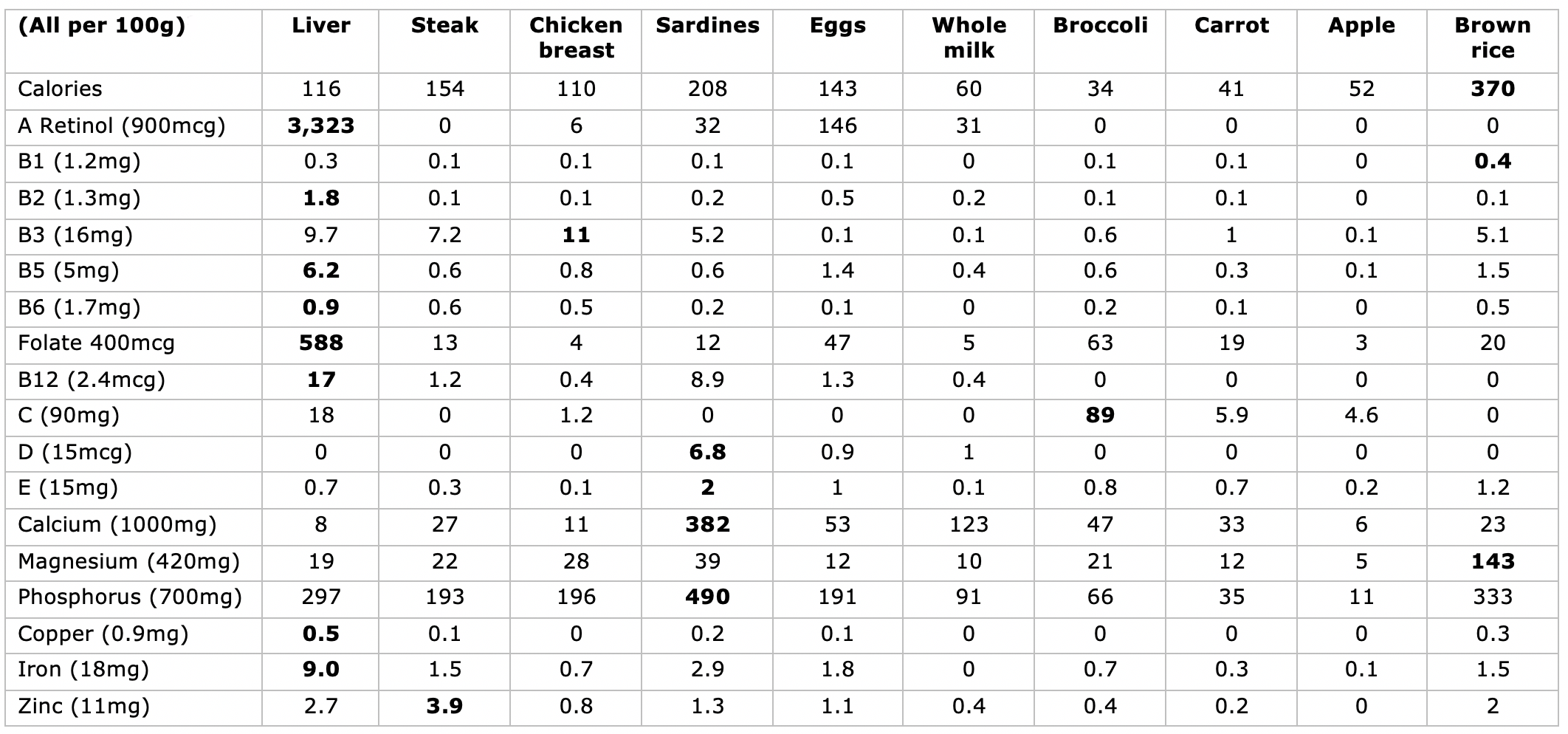
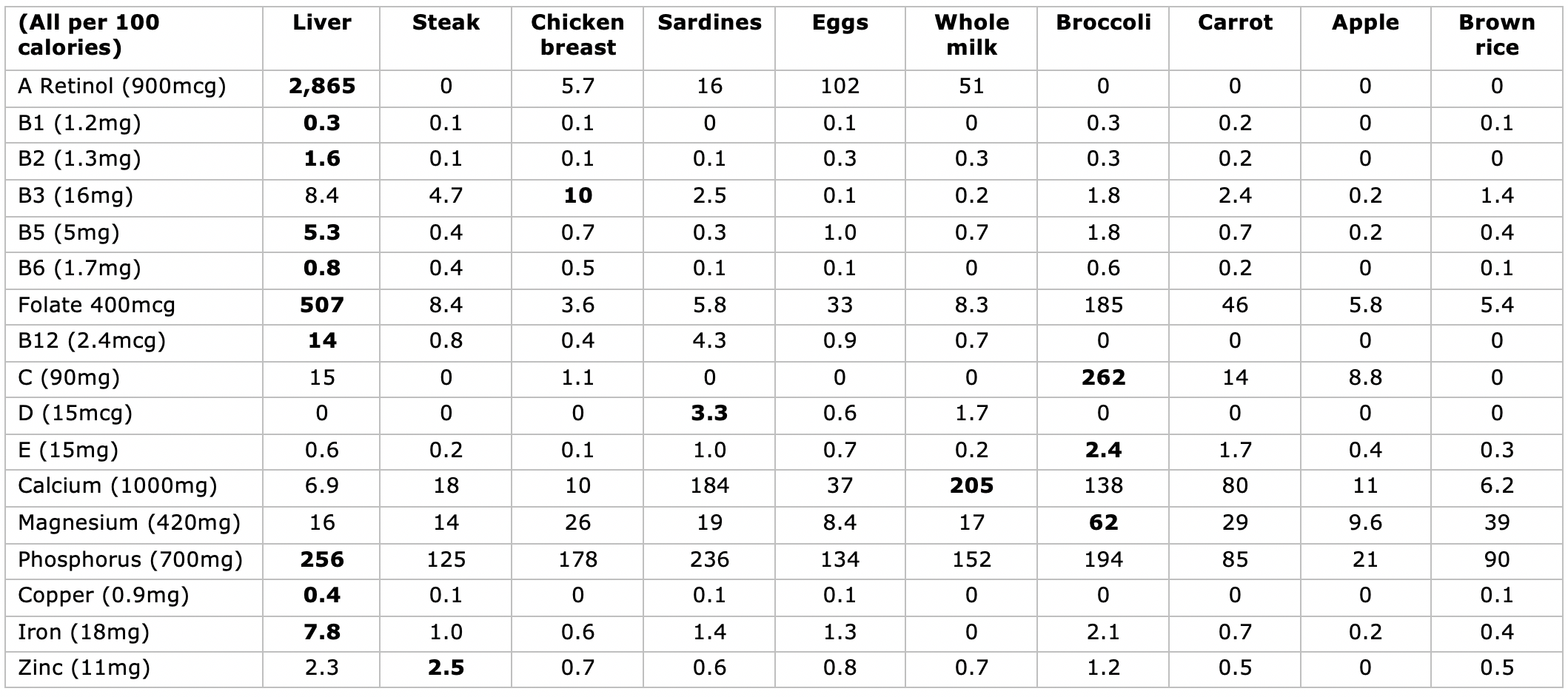
Below is a summary of what we are currently advised to eat (vegetables, fruit, grains, legumes and vegetable oils) vs the most nutritious food groups (meat, fish, eggs and whole dairy) when measured against essential nutrients. What we are advised to eat lacks essential fats in the right form, complete protein, retinol, D3 and B12. The vegetable oils that we are advised to eat are spectacularly useless. Animal foods provide what humans need.
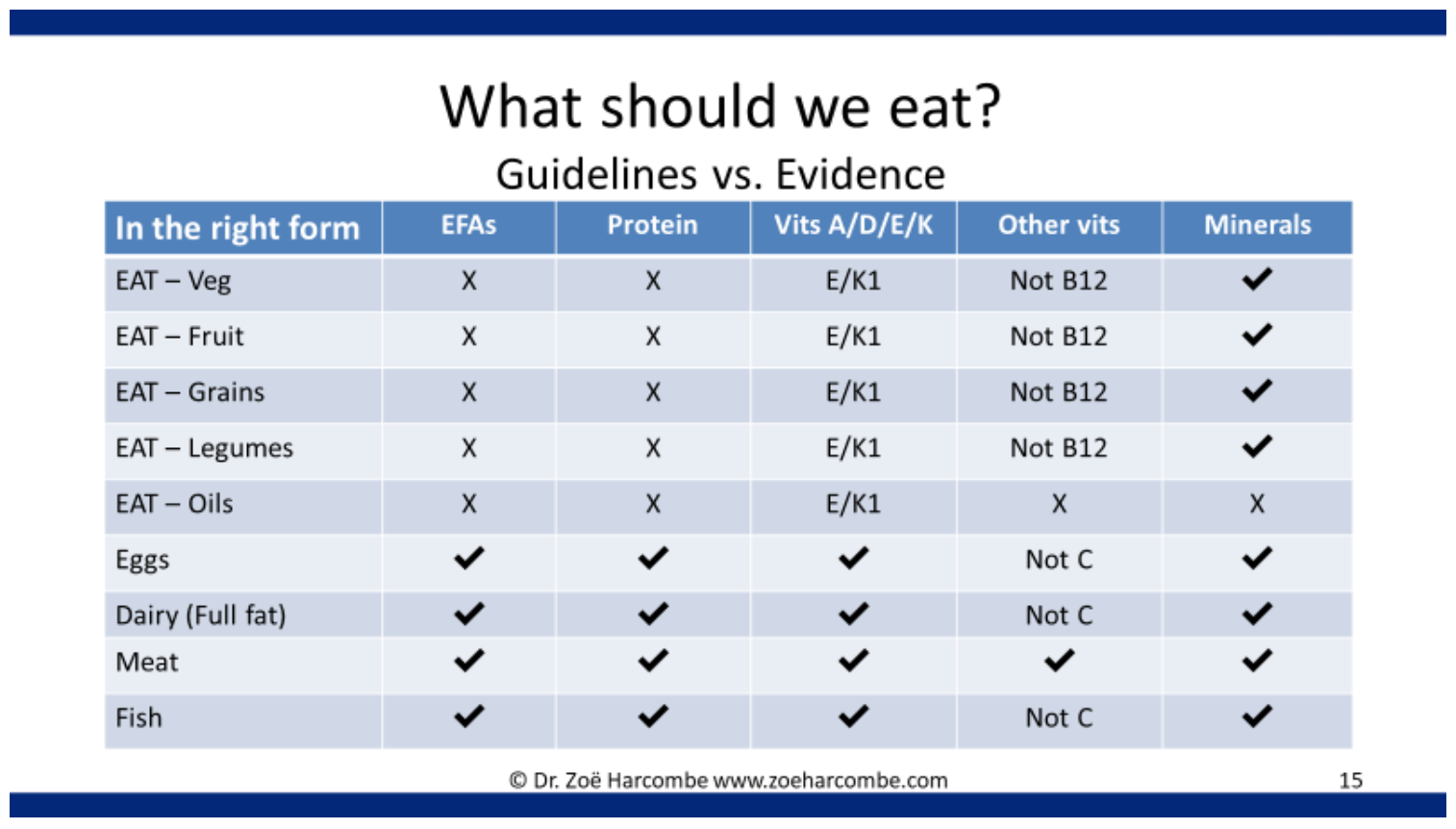
Nutritional deficiency
Government Family Food Surveys consistently report the UK’s nutritional deficiencies. The 2015 report confirmed that retinol intake was half the recommended amount (Ref 16). Vitamin D intake was barely one fifth of requirements. Vitamin E was deficient, and vitamin K not even reported. Nothing is being done about this nutritional crisis. Emergency instructions should be issued to eat more animal fat. Instead it is demonised, while carbohydrates are eulogised.
When the ‘eatwell’ plate became the ‘eatwell’ guide (March 2016), five menus were published by Public Health England (PHE), which I analysed and averaged. The PHE recommended diet is deficient in: retinol (less than a quarter of the recommended amount); vitamin D (approximately a quarter was provided); vitamin E (less than half); calcium was inadequate; K2 was not reported, but would have been deficient, given the extraordinarily low-fat meals (Ref 17).
The EAT Lancet diet was published in January 2019 (Ref 18). I analysed its nutritional value and similarly found serious deficiencies in the fat-soluble vitamins (retinol, vitamin D, vitamin K). Calcium, iron, EPA, and DHA were also deficient, as would B12 be if the optional, paltry, animal foods were not consumed. I submitted a letter to the Lancet pointing this out. The letter was not published. I published the correspondence here (Ref 19).
The environment
Fortunately, prioritising meat and dairy from pasture fed ruminants is also the right way to eat to protect the environment and our future. Without ruminants grazing the land, we will have no topsoil and thus no ability to feed the world naturally. The agri-chemical companies behind The EAT Lancet diet (below) gain in a world without soil. Everyone else loses.
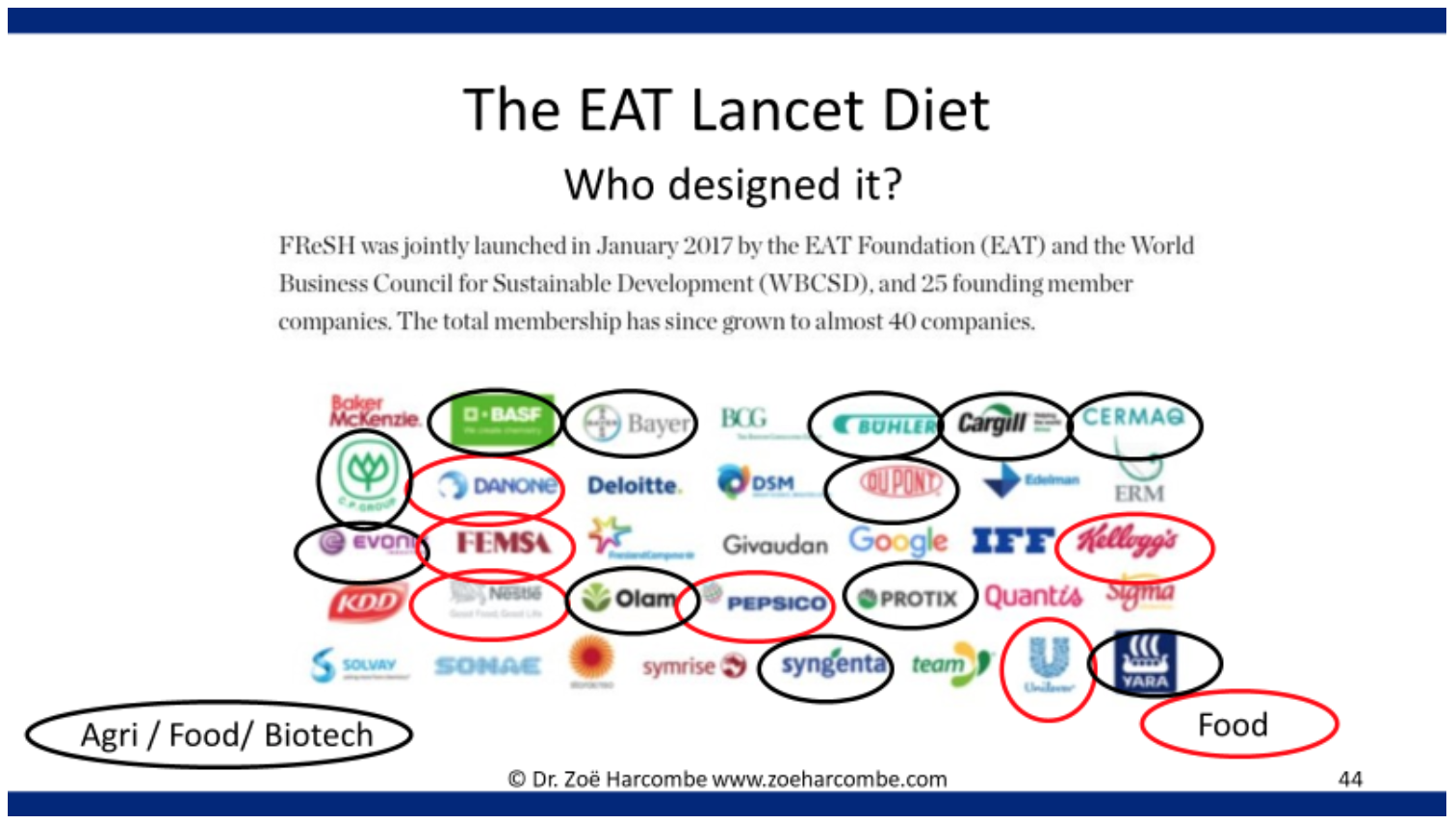
Summary
Our food strategy should be:
1) Eat real local food;
2) Choose that food for the nutrients it provides.
That means staple foods for British people should be meat, dairy, fish, eggs and vegetables. Seasonal fruit, wheat, barley, oats and potatoes meet (1) more than (2), but can also play a valuable part. We should not be eating bananas all year round or American cookies at any time.
————-ENDS—————
References
Ref 1: https://www.youtube.com/watch?reload=9&reload=9&v=yGB41LtcGW0
Ref 2: https://www.gov.uk/government/publications/developing-a-national-food-strategy-
Ref 3: “The lower limit of dietary carbohydrate compatible with life apparently is zero, provided that adequate amounts of protein and fat are consumed.” (p275) The Panel on Macronutrients. Dietary Reference Intakes for Energy, Carbohydrate, Fiber, Fat, Fatty Acids, Cholesterol, Protein, and Amino Acids (Macronutrients): The National Academies Press, 2005.
Ref 4: Simopoulos. The importance of the ratio of omega-6/omega-3 essential fatty acids. Biomed Pharmacother. 2002. (Cited over 3,200 times) https://www.ncbi.nlm.nih.gov/pubmed/12442909
Ref 5: https://nutritiondata.self.com/facts/beef-products/3186/2
Ref 6: http://nutritiondata.self.com/facts/dairy-and-egg-products/69/2
Ref 7: https://nutritiondata.self.com/facts/finfish-and-shellfish-products/4072/2
Ref 8: https://nutritiondata.self.com/facts/dairy-and-egg-products/111/2
Ref 9: https://nutritiondata.self.com/facts/fats-and-oils/572/2
Ref 10: http://nutritiondata.self.com/facts/nut-and-seed-products/3138/2
Ref 11: https://nutritiondata.self.com/facts/cereal-grains-and-pasta/5706/2
Ref 12: “The accepted 6:1 equivalency of beta-carotene to preformed vitamin A must be challenged and re-examined in the context of dietary plants.” Solomons, N. W. and J. Bulux. “Plant sources of provitamin A and human nutriture.” Nutrition Review, July 1993.
Ref 13: “Diabetics and those with poor thyroid function cannot make the conversion. Children make the conversion very poorly and infants not at all.” Sally Fallon and Mary G. Enig, “Vitamin A”, (March 2002).
Ref 14: Not all nutrients are available e.g. vitamin K and biotin are not well reported. Sodium and potassium have been omitted, as they are ubiquitous.
Ref 15: Liver: http://nutritiondata.self.com/facts/poultry-products/666/0
Steak: http://nutritiondata.self.com/facts/beef-products/7493/0
Chicken breast: https://nutritiondata.self.com/facts/poultry-products/701/2
Sardines: http://nutritiondata.self.com/facts/finfish-and-shellfish-products/4114/2
Eggs: https://nutritiondata.self.com/facts/dairy-and-egg-products/111/2
Whole Milk: https://nutritiondata.self.com/facts/dairy-and-egg-products/69/2
Broccoli: http://nutritiondata.self.com/facts/vegetables-and-vegetable-products/2356/0
Carrot: https://nutritiondata.self.com/facts/vegetables-and-vegetable-products/2383/2
Apple: http://nutritiondata.self.com/facts/fruits-and-fruit-juices/1809/2
Brown rice: http://nutritiondata.self.com/facts/cereal-grains-and-pasta/5706/2
Ref 16: A National Statistics Publication. The Family Food Survey. In: DEFRA, ed.: The Department for Environment, Food and Rural Affairs, 2015.
Ref 17: https://www.dietandhealthtoday.com/2018/07/the-eatwell-guide-is-nutritionally-deficient/
Ref 18: Willett W, Rockström J, Loken B, et al. Food in the Anthropocene: the EAT Lancet Commission on healthy diets from sustainable food systems. The Lancet 2019.
Ref 19: http://www.zoeharcombe.com/2019/03/letter-to-the-lancet-re-eat/

